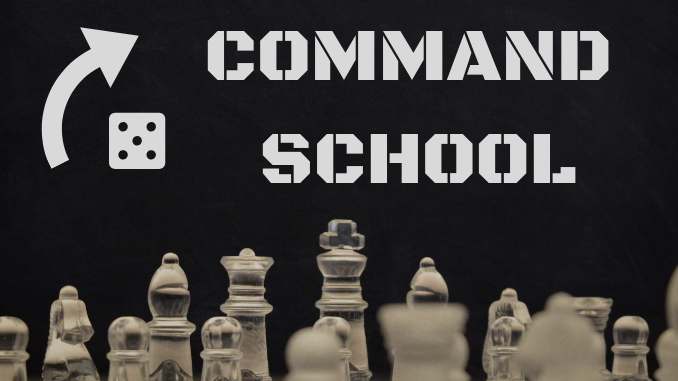
“Don’t put in a throwaway CoA just because the Commander wants to see three. He always picks the throwaway CoA…” – Unknown, tired staff officer.
Good welcome, gamers. Although my long-running Star Wars RPG fan content series, The HoloNet Uplink, has come to an end I just could not stay away from this blog. This is the second in a new series devoted to applying strategy and tactics to the world of tabletop gaming. The first laid down the differences between strategy and tactics, and why that matters. Today, we put on our thinking caps to develop some courses of action.
Courses of Action
A Course of Action (CoA) is a conceptual option to solve a problem. Not as detailed as a plan, it provides a broad concept that can be compared against other CoAs to allow for an informed decision.
In NATO militaries, CoA development generally occurs after significant thinking about the military problem and the options of the enemy in the Orientation or Mission Analysis step of operational planning. The details of that are best left for some other time. For now, it is enough to say that you should give thought to the nature of the problem you are trying to solve, including understanding what you must do versus what you can’t or shouldn’t do, as well as what your opponents may do.
The type and level of detail put into a CoA will vary based on the problem to be solved. The type of details needed in a CoA for an infantry platoon to attack an objective will differ from fighting a wildfire, or from taking more market share in an industry, and so on and so forth. One detail I think you truly cannot omit, however, is a pithy name.
How do you come up with ideas for CoAs? This is a creative process. If you have time and a team, brainstorming can be very effective. You might consider an approach you always wanted to try, an approach you’ve taken in a different game, or even an approach an opponent has tried before. Another way to start might be to think of broad themes, for example fast versus slow, or direct versus indirect, or maybe shock vs stealth.
Abstractly, a complete CoA meets the following requirements best remembered using the mnemonic FACES:
- Feasibility: Is this CoA possible? Do I have, or can I get, the resources I need?
- Acceptability: Is this CoA worth it? Do the benefits outweigh the costs? Is it acceptable politically? Ethically?
- Completeness: Does this CoA answer the 5W + H (Who, What, When, Where, Why, How)? Does it include enough detail?
- Exclusivity: Is this CoA fundamentally different in some way from all other CoAs?
- Suitability: Does this CoA solve the problem? Does it achieve the task or mission? Can it beat what my opponents are likely to do?
So remember, gamers: your CoAs must have FACES.

Copyright Disney.
Explanatory Example: Rebellion
Yes, yes, two Rebellion examples in a row. I know. I’m just a huge fan of the game. I’ll be sure to give a different example next time so this does not turn into the Rebellion strategy blog. But given Gamer Nation Blog’s readers are familiar with the ins and outs of battle in a galaxy far, far away, it serves as a great way to explain concepts.
Rebel Opening
Given how asymmetrical Rebellion is, the Rebel setup and opening comes with major choices. First and foremost, where should the Rebels place their secret base? What should they do first to set themselves up for long term survival, and to score enough reputation, so they can win? What should they do with their modest starting forces?
While the Empire has several options open to it, let’s stick with two for the purposes of illustration: building up and sweeping the galaxy or using intelligence and striking surgically.
Thinking about the broad strokes of the Rebel early game, let’s consider where to put the base and how we plan to be effective in the game. One theme might be overt action, with heavy use of direct military attacks, versus covert action, relying more heavily on missions for the time being. Another big choice is whether to act in the Outer Rim, out of reach of the Empire, or in the Core, dangerously close to the Empire but perhaps where you are least expected. With that in mind, the following table serves as the start of CoA development.
| Name | CoA 1 – Get Off Our Space Lawn | CoA 2 – Go Big AND Go Home | CoA 3 – Slow and Steady |
| Theme | Overt, Outer Rim | Overt, Core | Covert, Outer Rim |
| Broad Concept | Place the Rebel Base in the Outer Rim. Quickly mass military forces and attack the Empire where they are weak. This will be accomplished by an early diplomatic mission to Mon Cal or Utapau for shipbuilding purposes. Base Location in Outer Rim allows surge of forces from the base. | Place the Rebel Base in the Core, hiding units in the Base. This puts the Rebels in good position for a variety of objective cards, or just to harass the Empire once their fleet spreads out. | Place the Rebel Base in the Outer Rim. Spread out military forces to maximize use for missions and to deceive Empire as to base location if possible. Try and run down the clock on the Empire: safely win by not losing vs unnecessary risk to win decisively. |
| Advantages | Possible to achieve local superiority if Empire spreads out. Gives lots of space and time before Empire can arrive at the base. | Empire highly unlikely to think of this, can achieve shock/surprise | Maximum base secrecy. Slow and steady, this is a largely low risk CoA that takes advantage of the Rebels’ lack of a time limit. |
| Disadvantages | Movement of forces from Base may reveal its location. The Empire may block with Palpatine opposing diplomatic missions. | Movement of forces from Base may reveal its location. The Empire may find the base VERY early. | Extensive use of characters for missions exposes them to capture and interrogation. This CoA is slow and cedes initiative to the Empire. |
| FACES | Meets. | May not meet.
Acceptability: High risk. |
Meets. |
Conclusion and Homework
This has been a quick take on how to develop CoAs. Hopefully, it helps you come up with a brilliant, unforeseeable plan that wins you your next game.
Eager to put this knowledge into practice? Think about a recent game you played and the choices you made in it. What other courses of action were open to you? Have a game coming up? Take the time to try and come up with three courses of action for winning the game. Remember to make sure those CoAs have FACES.
I’d also love to hear from you on what topics you’d like covered here. Want me to cover the art and science of deception? How about I talk about when winning to much can make you lose? Ever hear of schwerpunkt? Something completely different? Let me know in the comments.
Until next time, class dismissed.
